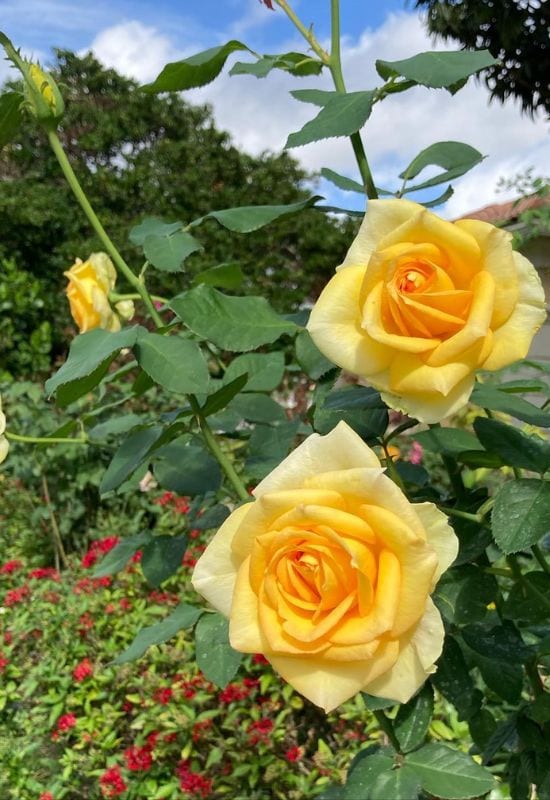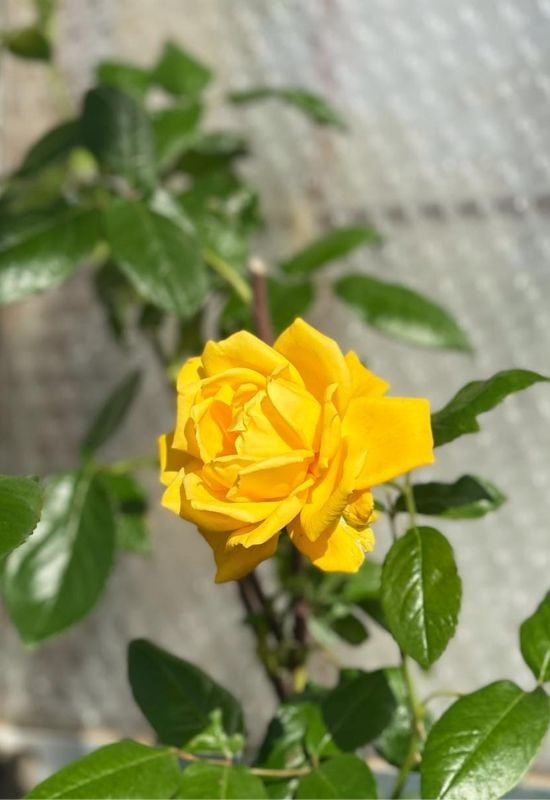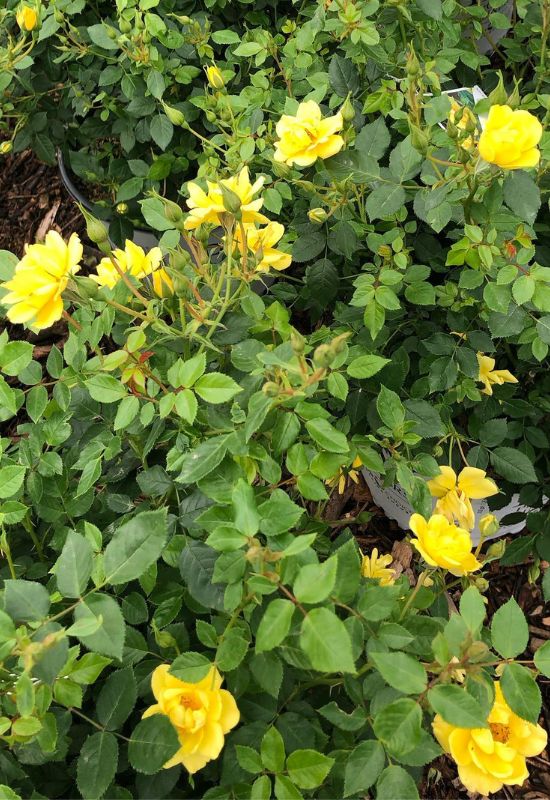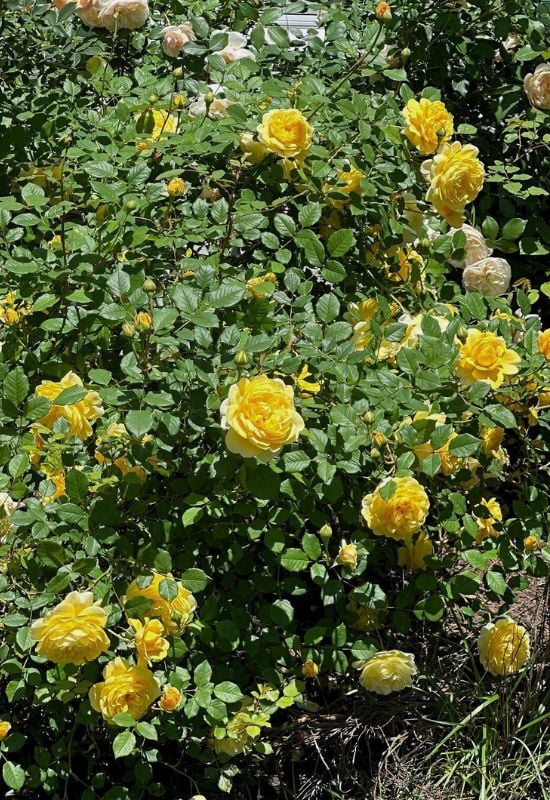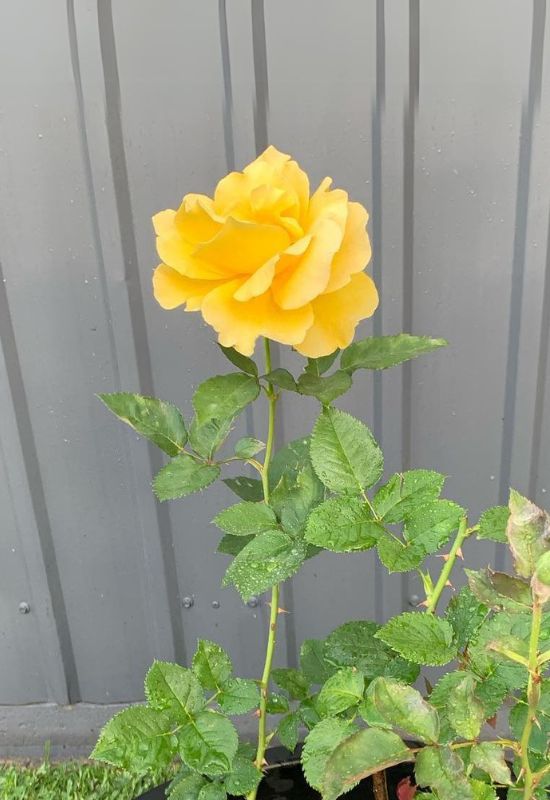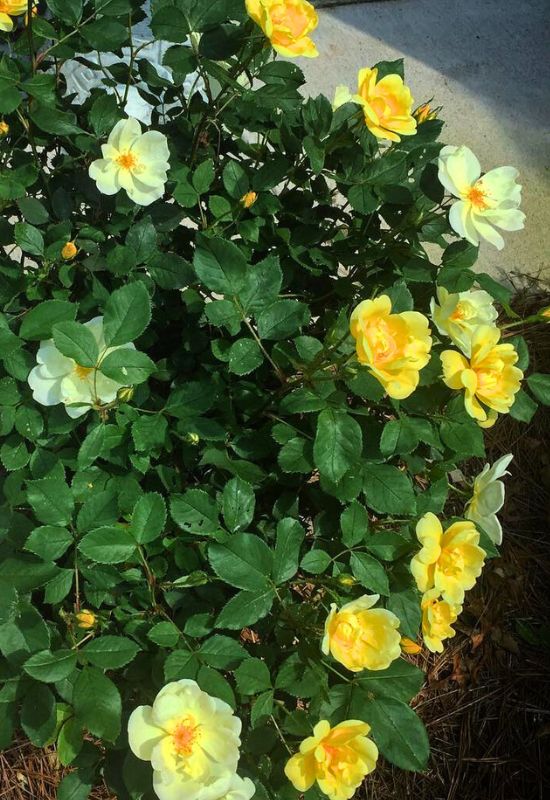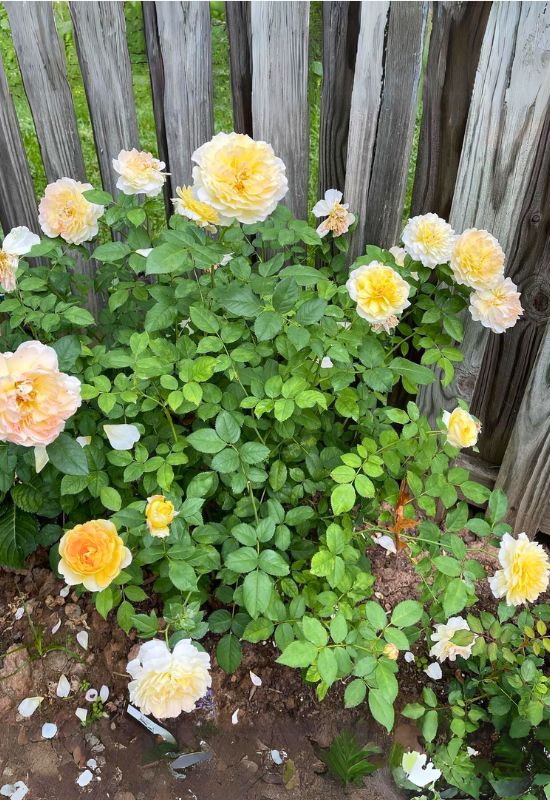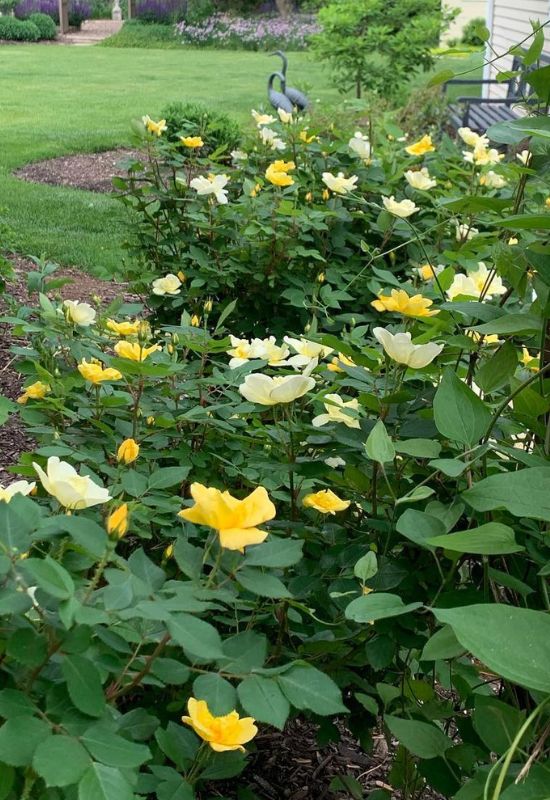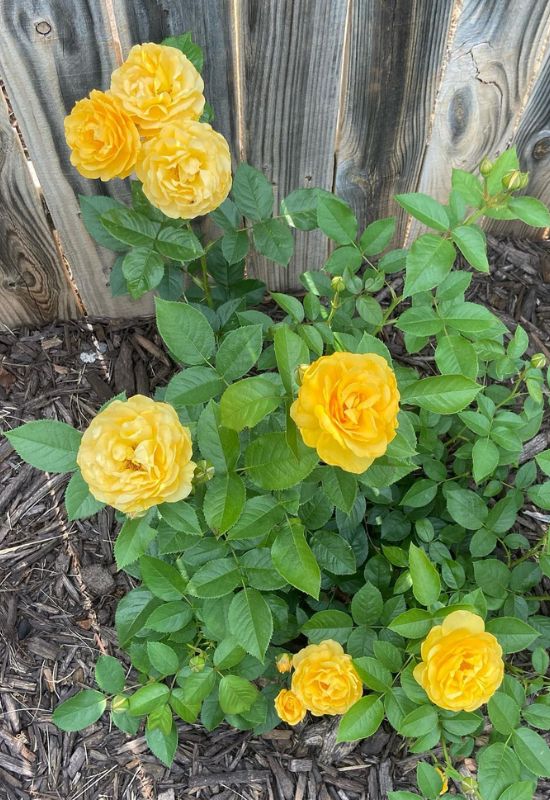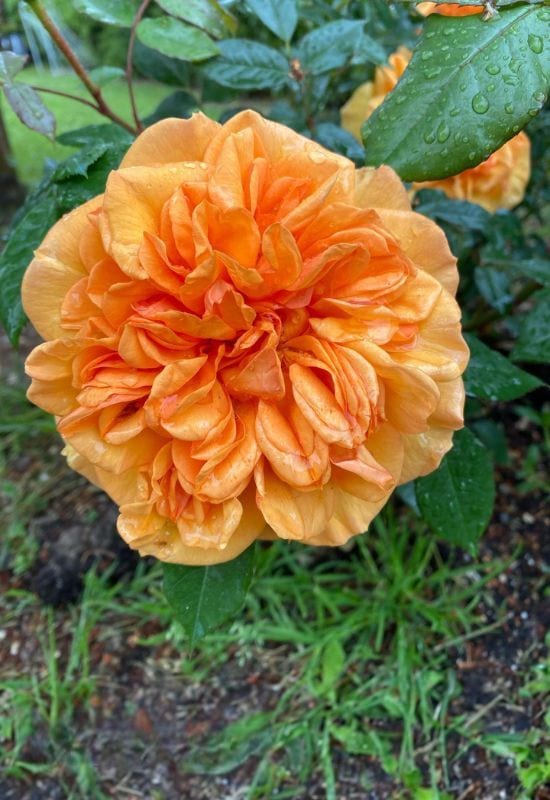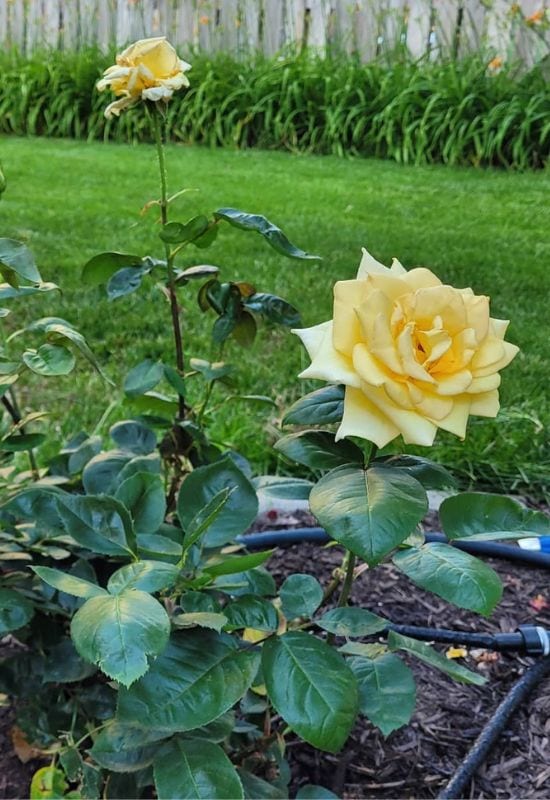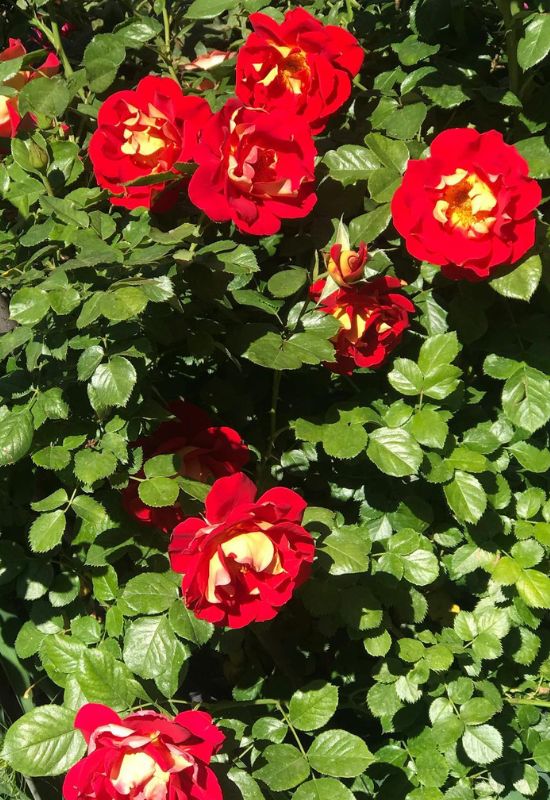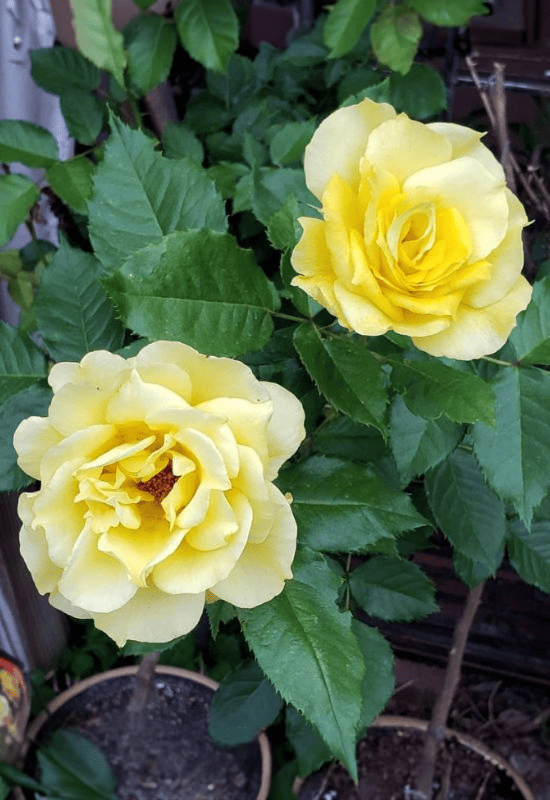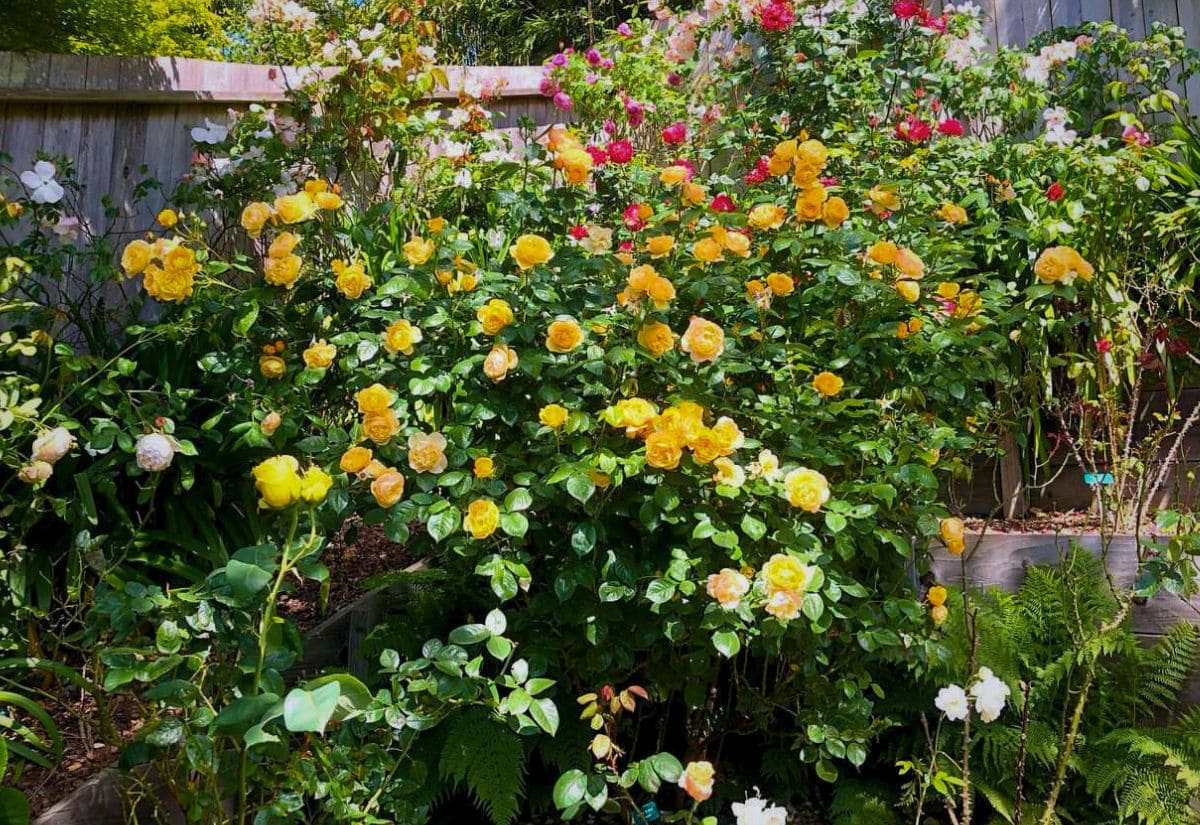
On a sunny day, yellow roses brighten up your borders and climb up walls and trellises with their blooms of pure energy and life. And on a cloudy or even a rainy day, the world’s most loved flower keeps the light of the Sun shining in your garden, sparking up among the green foliage that drape your gate or give a leafy backdrop to your beds. And if you need pure energy for your corner of heaven all through the season, you know what you have to do…
…You have to grow a yellow rose variety (or more) in your green haven to bring it to life! But which? Roses are not all the same, double, single, cupped, rosette and high centered blossoms, and yellow can be warm and dark, golden and sunrise, but also crisp and bright, with lemon, canary or chartreuse… And because this combination is so powerful, you need to pick a species of cultivar that really fits with your garden style, design, and needs.
And this is why you are here, and why we are here… To show you a wide range of the best roses in yellow shades, from many groups and types, so you can choose the best variety for you, your family and, of course, your garden!
Top 20 Sunny Roses with Yellow Blooms to Transform Your Garden into a Sunshine Spectacle
There are indeed many varieties of roses in golden or canary yellow and all its shades, and it was hard to make a selection of only 20 of the very best, but we made it, and here they are!
While they are all yellow, these roses are all different and one will surely meet your needs for borders, hedges, beds, pergolas, containers but also groundcover… Some are heirlooms, some young, and we can start with a classic looking cultivar!
1. ‘Graham Thomas’ English Rose (Rosa ‘Graham Thomas’)
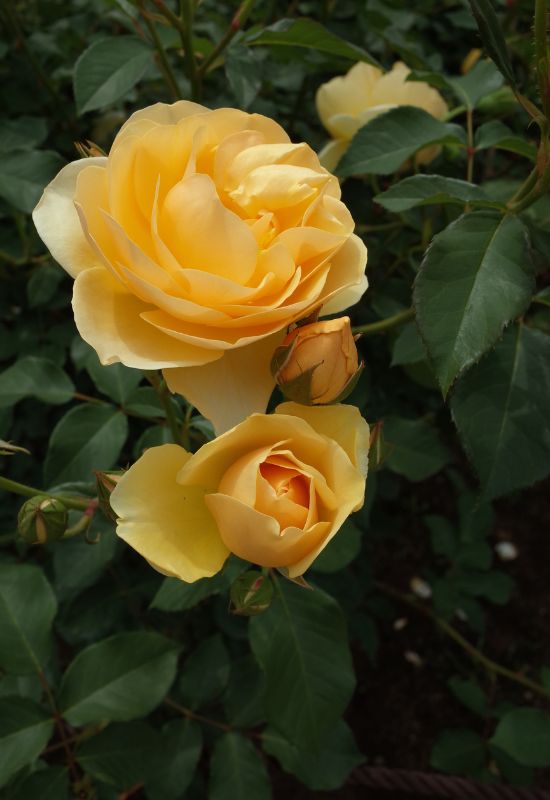
It is only fair to start with a variety that strikes a perfect balance between the highest pitches of the color of the Sun and the most classical shape of the queen of flowers: for this, ‘Graham Thomas’ is a match made in heaven!
As spring progresses, you will see elegant buds in red and yellow appear at the tips of the branches, in clusters, and they will open and start shining by March. Then, you will see the classically cupped blossoms of English roses spread to 4 inches (10 cm) each, and rich with petals that form informal but very dense rosettes, in fact up to 35 of them… And you will be impressed with their super intense, dark but bright shade of bumblebee, with golden tones, which is both warm and energetic!
And all this will happen again and again, with repeated blossoms, into the months of fall, and even frost! True to its hybridizer’s reputation, David Austin, who bred it in 1983, this tall shrub also has a strong fragrance with a fresh fruity scent and tea aroma! The hips will follow if you don’t deadhead its final display, with their shiny and glossy red, a great contrast with the mid to dark semi glossy leaves.
‘Graham Thomas’ English rose is real gardening royalty as well. In fact, it has many medals to shine with, on top of its blooms, including the prestigious Award of Garden Merit by the Royal Horticultural Society (1993), the James Mason Award from the RNRS (2000) and it was voted the World’s Favorite Rose by 41 societies in 2009! And it will warm and brighten up your garden as a shrub in a border or hedge, but it can also train as a climber for a golden gate or energetic trellis!
2. ‘St. Patrick’ Hybrid Tea Rose (Rosa ‘St. Patrick’)
We now meet a totally different variety: ‘St. Patrick’… Dedicated to the patron saint of Ireland, of course, it has the freshness of that Island, and it will give you a soft color effect with its pale cream yellow blossoms, which fade to whitish towards the margins as the high centered blossoms (or urn shaped, if you wish) mature, unfurling the outer petals but keeping a dense center.
Easy to do for these fully double flowers, because they have 63 to 69 petals each, and true to hybrid tea rose cultivars, they come on strong, upright and straight stems, and they do it in waves from late spring to fall. Accompanied by a mild but sweet fragrance, the blossoms are about 4.25 inches across (11 cm), quite showy and opening from long buds, which are themselves very decorative.
This medium sized shrub also blasts very lush foliage, which sets of the glowing quality of the floral display with matte but dark and leathery leaves, as it does with the shiny red hips that follow. Winner of the All American Rose Selection, it was introduced in the USA in 1986 by Frank A. Strickland.
An ideal choice if you love elegant soft yellow cut flowers, ‘St. Patrick’ hybrid tea rose will also grace your informal flower beds, at the back, or borders, and at the front of hedges, and you can also grow it in containers, in case you want its refined beauty on a patio or terrace. And, because it is s soft, not cold hardy variety, a pot could be the best choice if you live in a chilly country.
3. ‘Canary Bird’ Shrub Rose (Rosa x xanthia ‘Canary Bird’)
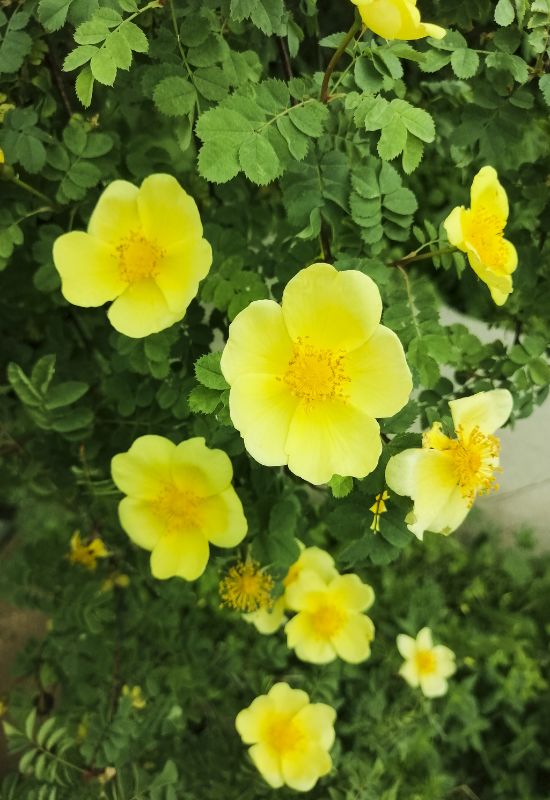
And just to show you that the combination of color and shapes has an infinite range of results, look at ‘Canary Bird’ shrub rose… Its flowers are single, with the classical five rounded petals of natural roses, and they only open for a short time, which is late spring, when they will also give you their light but pleasant fragrance.
The blossoms are about 2 inches across (5.0 cm) and they spread out fully flat, like stars, so you can enjoy their bright, crisp, fresh and luminous canary yellow, which pales to almost white at the edges. On the other hand, at the very center of the blossoms there is a ring of decorative and energetic golden stamens and anthers. This light filled visual effect will work as a landing pad for butterflies, bees and pollinators, that will come plentiful to visit your garden.
Not being a reblooming plant, you don’t need to deadhead it, so you can fully enjoy the many scarlet red and shiny hips that follow the floral display, and the many birds that come to feed on them. And yes, they are edible and rich in Vitamin C, and excellent in jams and jellies. Finally, you will also get a large shrub with very small and finely dented leaves, mid green in color and with a fern like texture. The only pity is that we don’t know who hybridized it, some time around 1907, but it has since won the much coveted Award of Garden Merit by the Royal Horticultural Society…
A large shrub with a bright and cheerful personality, ‘Canary Bird’ rose will work very well in hedges set in a traditional looking and informal garden, and it is also a good choice for uplifting yellow blooms in naturalized areas, where it also offers food and shelter to wildlife.
4. ‘Radiant Perfume’ Grandiflora Rose (Rosa ‘Radiant Perfume’)
‘Radiant Perfume’ is a real queen! Being a grandiflora rose variety, it has large blooms, of course, and they reach a considerable 5 inches across (12.5 cm), and they open from elegant and long buds, keeping a high centered shape, like a tall crown, indeed, for a long time, before spreading some of their 17 to 25 petals out… And they will do it repeatedly from late spring to fall, each time also filling your days with their sunny, bright, vibrant and intense golden yellow color!
It is actually quite consistent in time and over the whole blossom, which unfurls on top of tall, straight and strong stems. But of course, this royal jewel also has a strong fragrance, and it is quite crisp and uplifting, very citrusy and refreshing! All this long and spectacular display of floral riches and nobility will take place on a “stage”… The glossy and dark green backdrop of the lush foliage of this medium to large shrub. While it looks like it comes out of a fairy tale book set in a medieval realm, this is a young cultivar, only introduced in 2002 by US breeder Dr. Keith W. Zary.
‘Radiant Perfume’ grandiflora rose needs a very focal place in your garden, because it is a real prima donna, and it would anyway steal the show with its large crowned golden yellow blossoms and regal personality. Excellent to light up and energize a flower bed from the back, it can also spark up a hedge or border, or be a real jewel in a vase if you cut it and take it indoors.
5. ‘Oso Easy Lemon Zest’ Groundcover Rose (Rosa ‘Oso Easy Lemon Zest’)
But now, how about bringing light and energy to the lower levels of your garden? Instead of a tall variety, you would need a short one, and ‘Oso Easy Lemon Zest’ will only grow to a maximum of 3 feet, or 90 cm, giving you flowers that look up to you… A profusion of semi double blossoms will start opening to shallow cupped shapes from early summer and then again and again, literally continuously, into early fall, with a very brilliant, energetic and bright canary yellow color!
Each bloom is about 2 inches across (5.0 cm), and very pretty, with informally arranged round petals, and if you look inside, you will see a dense tuft of golden stamens and anthers. These will attract lots of butterflies, bees and other pollinators that cone to feed on the sweet nectar.
The main effect of this floral display comes from the number of the heads of this floriferous cultivar, that form a carpet of vibrant light over a low cushion of healthy and glossy rich green leaves. Then again, it is also true to its name when it comes to smell, because it has a strong lemon zest fragrance that can freshen up your sunny days. It is a recent cultivar as well, introduced in the USA by by Proven Winners.
Unlike other varieties, of course, you can grow ‘Oso Easy Lemon Zest’ for ground cover, and it is lower maintenance than other roses, very disease resistant and healthy, but also cold hardy. And you can easily have it in flower beds, given its size, or at the front of borders to frame them with brilliant yellow blossoms.
6. ‘Lutea’ Lady Bank’s Rose (Rosa banksiae ‘Lutea’)
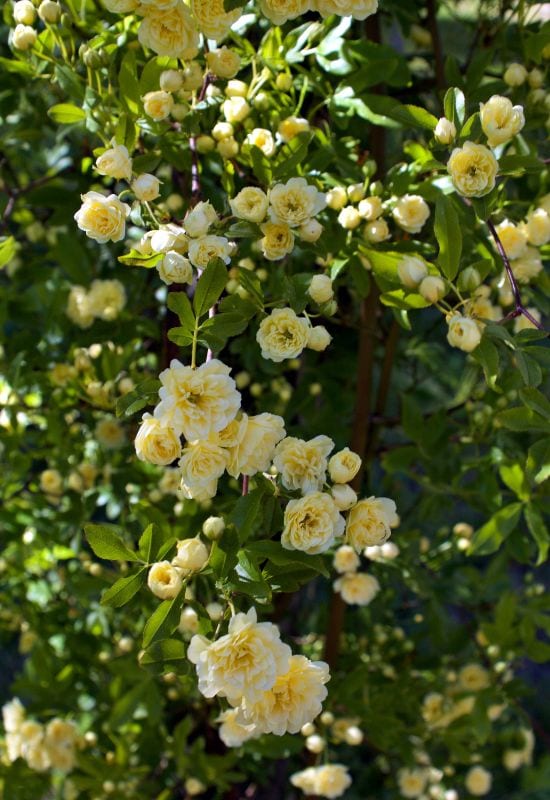
If we have looked down for vibrant energy, now we have to look up… Yes, because ‘Lutea’ is a real giant, and a variety of Lady Bank’s rose, which is very unusual indeed… Forming large rambling shrubs that reach a whopping 20 feet tall (6.0 meters) and 10 feet in spread (3.0 meters), you may even think it does not belong to the genus Rosa at all!
In fact, to start with it is totally thornless, and it blossoms so profusely from early summer to early fall that the floral display covers the whole bush, literally, almost like a forsythia, and in season, because its buds open in nearly spring, but they continue to early summer! Its flowers are about ¾ inch across (2.0 cm) and they are held in large clusters, with their soft cream yellow color, which is brighter in the center and it fades on the edges.
Each head has lots of frilly, long and fairly slender petals, that create a ruffled effect. They also have a mild fragrance, and this too is confusing, because it is reminiscent of violets! And then, the rich emerald green foliage has smooth margins, and, unusually, it is even semi evergreen, which means that it will stay on in warmer countries! And it is a very, very old heirloom variety, introduced as far back as 1850 by Camden Park in Australia, and it has since won the Award of Garden Merit by the Royal Horticultural Society.
You will understand that ‘Lutea’ Lady Bank’s rose needs a large space to express its bright and pale yellow floral display at best, and you can keep it as a large rambling shrub or grow it as a massive climber, in an informal landscape, as a hedge or over arbors, gates, walls and trellises. But its ideal place would be a cottage or country garden or even a naturalized area. Unfortunately, however, it is the least cold hardy variety of all…
7. ‘Suñorita’ Shrub Rose (Rosa ‘Suñorita’)
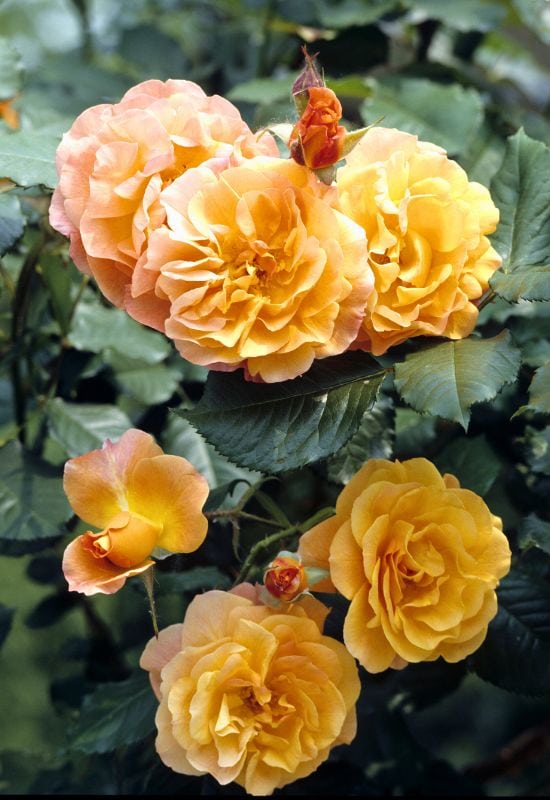
A chameleon with many impersonations, ‘’Suñorita’ shrub rose is not actually yellow, or at least, not at first, and you will have to wait a bit till you see the color of the Sun… Yes, because the blossoms start off in early simmer as peachy pale orange, and then they fade more and more to become golden, still with peach blushes…
So, if you like change and very refined tonalities, it may be the variety for you, but keep in mind that all through this process, the rosette shaped blossoms that reach about 4 inches across (10 cm) may just be what you are looking for. And they will continue this colorful spectacle into early fall, all the time unfurling to display the very dense tuft of saffron anthers and pistils inside, despite the 20 to 60 petals in each flower.
This will guarantee the buzzing and flying of bees, butterflies and other pollinators, which, despite its soft fragrance, cannot miss the floral display… And this is because it is perfectly set off by the very glossy and mid to dark green mound of dense leaves that form the small bush. Yet another recent cultivar by Proven Winners, USA, it is the most colorful of all on our list.
Of course, ‘Suñorita’ shrub rose is a great choice for containers, flower beds or borders in a garden that wants lots of colors and a vibrant display of mixing and changing shades, rather than just pure yellow. Grow it outside your main door and it will welcome you day after day with a new bright and cheeky face… And if this is your case, go ahead…
8. ‘The Poet’s Wife’ English Rose (Rosa ‘The Poet’s Wife’)
I think that if you are after pure energy and light, in the color of the Sun, you will love ‘The Poet’s Wife’! Its lyrical name does reflect its luminous beauty indeed, with its large flowers that come in late spring and they repeat their vigorous performance till fall… In fact, each blossom is cupped and with an internal and informal rosette of more than 41 petals, and they will shine with the brightest golden yellow ever.
At least at first because they will fade to whitish as they mature, but this only adds to the candid energy that they give to your summer days and garden! Opening on red, straight or bending stems and looking up to the sky, the individual blossoms spread to 4 to 5 inches in diameter (10 to 12.5 cm), giving you a really spectacular show.
This English rose variety will not only please your eyes, but also your nostrils, as it has a really strong, fresh and sweet fruity fragrance that persists till late in the season! A shrub cultivar introduced by worldwide famous breeder David Austin in 2014, it also gives you a great mound of semi glossy bright emerald green, healthy and arching leaves, that forms a perfect backdrop for its brilliant and long lasting floral display.
Ideal for luminous and bright flower beds and hedges, ‘The Poet’s Wife’ is perfect to bring the light of the Sun and golden blossoms through the season to informal gardens in many landscaping styles, from traditional cottage and English country gardens to urban and suburban yards. And it will definitely brighten up containers on a terrace or patio as well.
9. ‘Midas Touch’ Hybrid Tea Rose (Rosa ‘Midas Touch’)
Legendary King Midas had the power to turn to gold everything he touched, and that’s why ‘Midas Touch’, a prized hybrid tea rose, takes its name from him… Because its blossoms are perfectly, vibrant, energetic and bright golden yellow! And if this is what you are looking for, maybe the wait till mid summer, when the buds start opening, is worthwhile, but then they will continue in luminous flushes till early fall…
And for these three months, your garden will come alive with its large and semi double blooms, that reach 4 inches (10 cm) in diameter, and with 17 to 25 wavy petals that reflect the light. But if you get past them, maybe wearing a pair of sunglasses, you will also see the very dense and soft looking tuft of saffron colored anthers and stamens that attract loads of butterflies, bees and pollinators to your garden…
Born solitary on long, straight and strong stems, these brilliant flowers stand out magnificently against the glossy dark forest green foliage of this medium sized shrub, which emerge with copper reddish shades, for an extra touch of ruby luxury… Winner of the All American Rose Selection this cultivar was bred by Jack E. Christensen in the USA in 1992.
Being a hybrid tea variety, ‘Midas Touch’ is, of course, an excellent rose for cut flowers, but the light and golden energy it brings to your outdoor borders, hedges and containers will also brighten up your summer days with spectacular blooms. Take your pick…
10. ‘Sunny Knockout’ Shrub Rose (Rosa ‘Sunny Knockout’)
And here is a very playful variety for you: ‘Sunny Knockout’! It will literally amuse you when you see this shrub rose open its buds to reveal five rounded and wavy petals, spreading out flat, and reaching 3 inches across (7.5 cm) like little stars in your garden… Yes, because the single blooms are bright, decided, strong and energetic golden yellow as soon as they appear, and they will do it in late spring, to then continue in luminous flushes all the way to fall…
The tuft of pistils in the middle can be gold too, but the anthers can flare up to a dark reddish tonality as well… But then, after the first day, the color of the blossoms will start to change, becoming paler and paler, and moving into the cream range, and they finally end as ivory white while the heads are still very healthy and attractive… But new ones will open next to them in clusters, so you have a continuing shifting and changing of tonalities!
There are two constants in all this: butterflies and bees and pollinators will not be fooled by this transformation, and they will keep coming to your garden. And then, the very strong and crisp citrus fragrance they produce will be further proof that no one has replaced your shrubs overnight! The mound of dense and fern green foliage underneath adds even more brightness to an already light filled floral display, and it is all thanks to Will (called “Bill”) Radler who introduced this beauty in 1989.
Ideal to bring light and changing effects of golden yellow and white to borders and flower beds, ‘Sunny Knockout’ is a fairy small shrub rose you can use in most informal garden styles, from very traditional to mire modern, from countryside to urban.
11. ‘Monileux’ English Rose (Rosa ‘Monlieux’)
And we cone back to a cultivar that the most prestigious hybridizer of modern times has given us, David Austin. He introduced ‘Monilieux’, spectacular English rose variety, in 1994, and it is dedicated to his favorite soccer (football, has he would say) team. And he produced a champion, which has cast juries all over the world under a spell with its large, cupped and old rose flowers, which reach 4 inches across (10 cm) and they can pack up to a whopping 120 petals into a single head! This creates an internal rosette with an amazingly ruffled and silk like texture, on which the blossoms display a super vibrant and bright rich and dark amber yellow color!
True, they will fade a bit, but this will give you even more tonalities of golden, then canary, and they never stop being luminous. All this will bring sunlight to your garden from late spring to fall, while charming you with an amazingly strong fragrance of must and tea, over a dense and healthy mound of dark and glossy green leaves. And all this has gained it the Award of Garden Merit by the Royal Horticultural Society, the Gold Medal of the President’s for the Best New Rose of the Year, and the Henry Edland Medal as Best Scented Rose at the Royal National Rose Society Trail.
I don’t know if Wolverhampton Wanderers, David Austin’s favorite football team, ever got that many awards, but if you grow ‘Monileux’ English rose in your garden, it will spark up with the gold of its medals and bright yellow of its blossoms form months, making your bed, border fronts and containers shine with blooming glory like the podium of a flower contest! Not bad for a small shrub!
12. ‘Golden Gate’ Climbing Rose (Rosa ‘Golden Gate’)
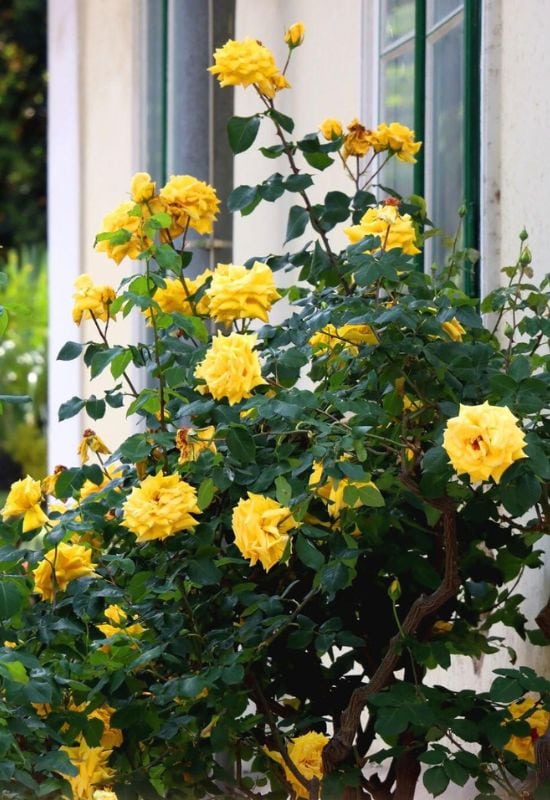
And why not drape a wall or a pergola with sunlight itself? Then ‘Golden Gate’ can do it for you climbing 8 to 12 feet (2.4 to 3.6 meters) onto gates and trellises, and lighting them up with double blossoms from early summer to fall. Loosely cupped, the flowers have 55 to 60 elegant and gently dented petals, opening to 3.2 inches across (8.0 cm) from decorative ovoid buds, and it shines with a bright golden yellow shade.
This will then slowly fade to cream as time goes by, starting at the margins, but this floral display will not lose energy and luminosity for months on end! And the fragrance you will enjoy is also in theme with the personality and color of this rose; medium in strength it has a distinct fruity banana aroma, but freshened up by strong citrus notes.
The clusters of blooms will repeat their performance in flushes over a backdrop of lush, leathery and semi glossy mid but rich green foliage, with pretty large leaves, and the hips that follow with their vibrant red offer a striking contrast. Introduced to the gardening world in 1995 by Tim Hermann Krodes, it has since won the famous Award of Garden Merit by the Royal Horticultural Society.
Being a climbing variety, of course, ‘Golden Gate’ needs some support to display its brilliant yellow blossoms; any strong trellis, gate, fence, pergola or arbor will do perfectly well, and your days will be filled with sunlight through the summer and into fall, even when it rains or it is cloudy.
13. ‘Flower Yellow Carpet’ Groundcover Rose (Rosa ‘Flower Yellow Carpet’)
Let’s now move to lower levels of your garden; ‘Flower Yellow Carpet’ groundcover rose only grows to a maximum of 3 feet (90 cm), but it us very vigorous when it comes to blooming… An early starter, it will start opening its buds in mid spring, just when daffodils are at their best, and it will keep your garden alive with light and color all the way to frost!
This long lasting floral display is quite dense as well, because the many flowers are “only” 2 inches across (5.0 cm), but they come very profusely in clusters of about 6 heads that almost cover the little shrub completely. Each blossom can have up to 30 petals, informally arranged into a rosette wit a flat base, with a ruffled look and a warm cream yellow color, which is fairly consistent in time.
When they open fully, you can see the tuft of stamens with rust red anthers in the middle, as will pollinators. It is only lightly scented, but it makes up for it with its dense cushion of rich green and healthy glossy leaves. Yet another winner of the Award of Garden Merit by the Royal Horticultural Society, it was bred by German hybridizer Werner Noack in 1990.
Of course, you can grow ‘Flower Yellow Carpet’ rose as ground cover, mass planting it for huge and long but low yellow floral displays, but its size also makes it ideal for flower beds, containers, and even at the front of borders.
14. ‘Julia Child’ Floribunda Rose (Rosa ‘Julia Child’)
But now we can move into the mellow range of our color, and the soft shapes of our plant: meet ‘Julia Child’ a really welcoming floribunda rose variety. In fact, its fully double blossoms have a cupped shape and a really warm and almost “melting” dark butter yellow shade, which is quite reliable and stable throughout the season.
Opening from late spring to early fall, the flowers have about 35 round and regular petals that form really decorative, almost sculptural rosettes, unfurling in a spiral from the middle. Each bloom is about 4 inches across, and they keep together in clusters, heightening the effect with their numbers.
Quite floriferous, this cultivar will also give you a distinctive licorice and cloves fragrance, to please your nose till the red and shiny hips come, scattered over a bushy mound of glossy, mid and rich green leaves that pack the small and compact shrub. In 2006, this shrub won the All American Rose Selection, the most important prize for our genus in the USA, and thus was only two years after Tom Carruth introduced it in 2004.
Ideal for containers, ‘Julia Child’ can also give a sense of luminous and peaceful warmth to flower beds and border fronts, and it will also provide your indoor spaces with wonderful butter yellow blossoms as a cut flower.
15. ‘Charlotte’ English Rose (Rosa ‘Charlotte’)
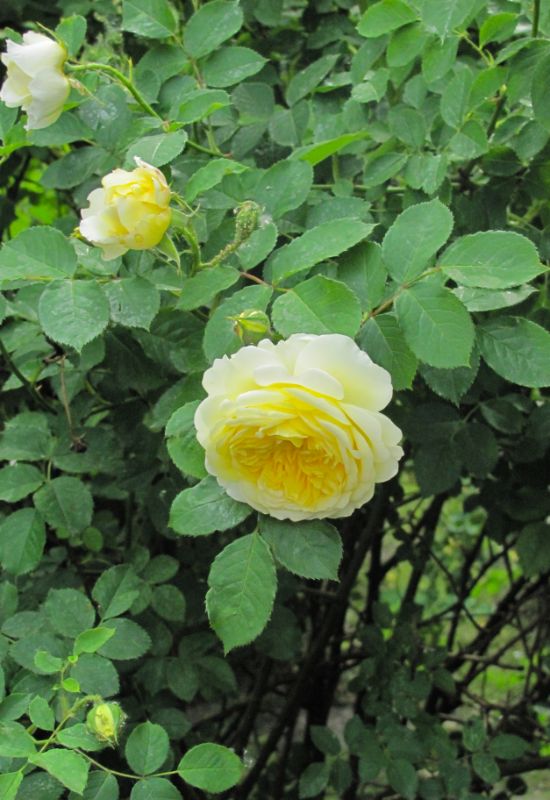
If you like the old world look, atmosphere and gardening style, ‘Charlotte’ may well be the perfect variety in our color for you! Just look at the cupped blossoms of this English shrub rose, and you will understand why… Starting in late spring, they are quite big, at a considerable 5 inches across (12.5 cm), but this is only part of their showy beauty…
Each individual flower can have a mind blowing 100 petals (!!!), and they are arranged into a very ruffled and flat topped rosette, looking up to the sky, or the Sun, on straight and upright stems. Their shade is described as soft or butter yellow, but I beg to differ… They reach brilliant notes of golden at the center, and then they fade as the blooms age, then moving into less vibrant tonalities, till they reach a cream hue before wilting away…
This time you will also enjoy its pleasant tea fragrance, as this floral display shines just above a bushy mound of dark green and semi glossy leaves till fall comes, and even to the first day of frost. It is yet another cultivar we need to thank David Austin for, who dedicated it to his granddaughter in 1993, when it was introduced. And it has since won the Award of Garden Merit by the Royal Horticultural Society.
‘Charlotte’ English shrub rose will definitely take center stage at the back of your borders or in hedges, thanks to its bug and bright blossoms; it will definitely bring a traditional atmosphere to your green space, and, in fact, it is ideal for an English country or cottage garden. Hardier than most varieties, it can also be trained as a climber and jt gives you really outstanding cut flowers!
16. ‘Golden Beauty’ Floribunda Rose (Rosa ‘Golden Beauty’)
‘Golden Beauty’ must have a sunny place on our list. And it is not just for its name, but for many reasons… Being a floribunda rose variety, it will open its buds in clusters, giving you groups of rosette shaped blossoms with a flat base, and 17 to 25 wavy and dented petals, with a very traditional old world shape. About 4 to 5 inches in diameter (10 to 12.5 cm) these flowers will literally wow you with their intense, dark amber yellow color, which almost touched on orangish tonalities.
True, they will fade as they mature, but they will become fully golden and still keep their bright and luminous personality through the season, which starts in late spring and keeps going in flushes till fall. The blooms also have a slight but sweet and very pleasant fragrance, and they warm up the backdrop of bright emerald green and glossy foliage that fills the balanced shrub.
It is also a champion, having won the Award of Garden Merit by the Royal Horticultural Society, but also the Gold Medal (how fitting) at both the National and International Rose Trial Award, as well as the People’s Choice Award in 2018! These must make W. Kordes & Sons very proud, who introduced it in 1994.
‘Golden Beauty’ is one of the darkest varieties of yellow roses, but with a vibrant amber shade, so it can literally warm up your borders and containers, or flower beds at the back, with its luminous blossoms and it can also do it indoors, as a cut flower.
17. ‘Oregold’ Hybrid Tea Rose (Rosa ‘Oregold’)
On to another iconic shape of roses in our color, we now find ‘Oregold’ on our sunlit path… This is a hybrid tea variety, and as such, it has long, straight and upright stems, that add to the elegance of its blossoms, which are high centered, as we say, which means that they open from long buds and take on an urn, teacup or teapot shape before they open fully and wilt…
Very elegant indeed, the flowers will come in flushes from late spring to fall, and they are also quite sizable, ranging between 4 and 5 inches across (10 to 12.5 cm). Then again, the 30 to 35 petals on each head makes them quite full, and this goes perfectly well with the bright yellow light in gold first, then fading to cream tonalities, that the blooms offer to your garden. I must say that I don’t find the tonality of this cultivar very stable, and it may vary a bit, maybe depending on growing conditions.
Nevertheless, they will always stand out quite clearly with their light but pleasant fragrance against the dark green and glossy leaves, sometimes with purplish reflexes, of this fairly large shrub. A winner of the All American Rose Selection, this vibrant beauty was bred at some stage before 1970 by Mathias Tantau Jr., making it an heirloom cultivar.
One of the best varieties for showy cut flowers, ‘Oregold’ hybrid tea rose can also bring its elegant and bright blossoms to your borders and hedges, for a really regal yellow floral display. It could also fit into a large container, being less cold hardy than other varieties…
18. ‘Ketchup and Mustard’ Shrub Rose (Rosa ‘Ketchup and Mustard’)
But we haven’t seen a double variety yet! True, but we kept you waiting for a really striking, and young cultivar: ‘Ketchup and Mustard’ shrub rose! What can be more powerful, energetic and vibrant than the match of red and yellow? And this is what our bold beauty will give you and your garden, starting in early summer for about three months, and it will do it in style.
In fact, the two tonalities are clearly separated, as the 28 petals has a really velvety scarlet to carmine red front, sometimes touching heights of ruby. But the back is dark golden to banana, and this gives you the most amazing contrast ever! This is even more impressive because the blossoms have the elegant and refined high centered shape of an urn, or teacup, and the two shades keep distinct, drawing really decorative patterns!
And this will make a bold statement, as the flowers, that usually come individually on long and upright stems, are a whopping 3.2 inches across (8.0 cm)! They only have a light fragrance, but this spectacle of fireworks is lit up even further by the glossy and bright green leaves of the dense foliage. While it was only introduced in 2008 (or just before) by Christian Bédard in 2008, it is becoming super popular, especially with florists!
I can hardly find another rose variety that can bring so much energy and light to your garden than ‘Ketchup and Mustard’… It will definitely make a bold and dramatic statement in your hedges or containers, and if you grow it at the back of flower beds, make sure you put super vibrant varieties in front, or it will steal the show. Cold hardy as well, you could well take it indoors in a vase in case the light goes out.
19. ‘Sunsprite’ Floribunda Rose (Rosa ‘Sunsprite’)
And now we come to a real explosion of pure light, with ‘Sunsprite’… Yes, because this rose has really big blossoms, about 3.2 inches in diameter (8.0 cm) and they come in energetic flushes from late spring to fall. But, being a floribunda variety, they come in clusters, so and the bright and luminous, rich golden yellow color and energy that they display grows exponentially in your garden.
The flowers boast about 30 petals, but they also have a strange behavior… As they open, they keep a high centered shape, like an urn, which is very elegant indeed… But as days go by, they unfurl more and more, till they become wavy and informal open rosettes with a flat bottom. At that stage, the blooms will have faded to cream tonalities, especially at the margins, but they will also reveal a tuft of stamens that hold tine rust red anthers.
And this will tell butterflies, bees and other pollinators it is time to visit you! Boasting a strong fragrance, described by some as close to cinnamon, it is hard to miss this luminous floral display against the mound of glossy dark leaves that fill this small shrub… It is an heirloom cultivar as well, bred by Reimer Kordes back in 1973.
…And it has since brought its striking contrast of vibrant yellow and dark foliage to gardens worldwide, where it has lit up borders, flower beds and containers for half a century now, as it will do to yours if you pick ‘Sunsprite’ for your green haven.
20. ‘Henry Fonda’ Hybrid Tea Rose (Rosa ‘Henry Fonda’)
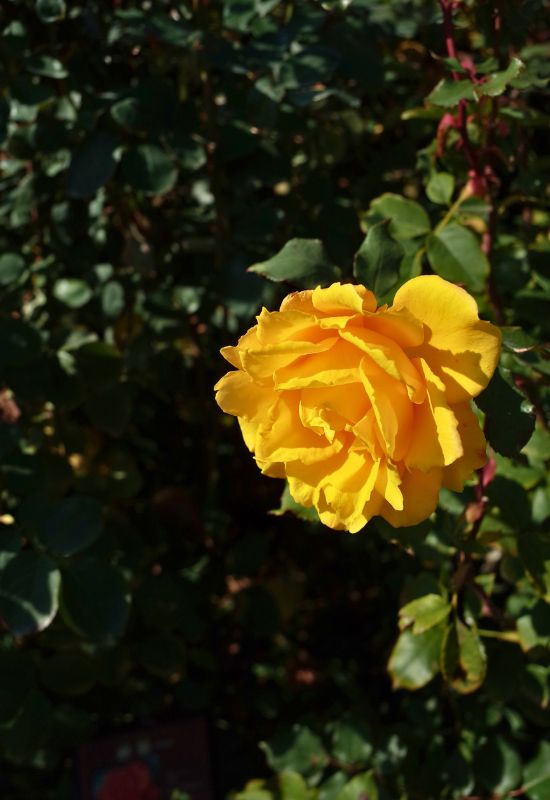
Now you can almost take your sunglasses off, but wait till you see the last surprise we have in store for you… ‘Henry Fonda’ an heirloom hybrid tea variety, is pure light! And why? To start with, its blossoms are really big, reaching a whopping 5 inches across (12.5 cm). So, come late spring, they will take center stage in your garden, also because they have the most saturated, bright, strong and pure golden yellow color!
True, this impressive tonality will fade away as the blooms age, and they open to an informal rosette, but new buds will unfurl in flushes all the way to the months of fall… And, coming on strong, upright and long stems, they do make an impression, and a bold statement, till they reveal the saffron colored tuft of stamens and anthers in the center. And there, you will notice that little pollinators and bees have found a good place to eat some sweet nectar, but now butterflies will be welcome as well… But there is more…
The 26 to 40 petals in each double head can sometimes have a soft tip, but sometimes they are dented and lobed, even frayed and torn, giving the blossoms a frilly personality… The only pity is that they have little or no fragrance, but they really stand out against the very dark green leaves with purplish margins and on purple stems that make a give a really sumptuous backdrop to this sunny floral display. Yes, you guessed, it is dedicated to the famous US actor, and it was introduced to the world of gardening in 1995 by Jack E. Christensen, bit it has since become so famous that it has its own Wikipedia page!
Forming a medium shrub, ‘Henry Fonda’ hybrid tea rose is ideal for birders, but also at the front of hedges and at the back of beds or in containers, it can bring its bright golden blooms on a dark leafy backdrop like many suns lighting up at night. And, of course, you can repeat this indoors with cut flowers. Unfortunately, it is a fairly soft variety, so, you may need to grow it in a pot in a cold country.
Lots of Light for Your Garden with Yellow Blooming Rose Varieties
Now you can take your sunglasses off! We have come to the end of this sunny and light filled journey…
Of all these amazing varieties of roses with yellow blossoms it is really hard to choose one… Gold or butter or amber flowers, rosette or cupped or hugh centered blooms, rambling, climbing or shrub in habit, all these cultivars have something different to offer you and your garden.
But there is one thing that they all have in common, and it is the energy of the Sun itself, and the amazing beauty of the most famous and loved flower all over the world!

Written By
Amber Noyes
Amber Noyes was born and raised in a suburban California town, San Mateo. She holds a master’s degree in horticulture from the University of California as well as a BS in Biology from the University of San Francisco. With experience working on an organic farm, water conservation research, farmers’ markets, and plant nursery, she understands what makes plants thrive and how we can better understand the connection between microclimate and plant health. When she’s not on the land, Amber loves informing people of new ideas/things related to gardening, especially organic gardening, houseplants, and growing plants in a small space.

